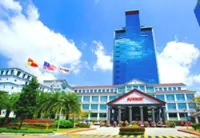KUCHING: Sarawak’s Bakun hydroelectric dam reservoir is expected to host a large-scale solar floating farm by 2027.
The initial phase of the floating solar farm project at Bakun dam is expected to generate up to 300MW, according to Sarawak Energy Bhd (SEB) group chief executive officer Datuk Sharbini Suhaili.
He said the project is slated for completion in the next 18 to 24 months.
Last week, the Sarawak Utility and Telecommunication Ministry inked a memorandum of understanding (MoU) with China Three Gorges International Ltd (CTGI) and Shanghai Electric Power T&D Group Co Ltd to collaborate on the project at the International Solar Photovoltaic and Smart Energy Conference in Shanghai.
The MoU sets the framework for the parties to jointly undertake studies and explore the potential development of floating solar, with a capacity not exceeding 1,000MW.
Sharbini said the Sarawak government had sought the assistance of CTGI and Shanghai Electric to study the development of floating solar farms at the Bakun dam reservoir as the site has a very large water body, which the state believes has a strong potential for large-scale solar energy generation.
“If we succeed in delivering this project, it is expected to generate up to 300MW of energy in its initial phase, which could become the largest of its kind in South-East Asia.
“We hope to gradually increase that capacity in the coming years, ultimately positioning Sarawak as a regional leader in floating solar energy,” he added.
The 2,400MW Bakun power plant at the upper Rajang River in central Sarawak was commissioned in 2011.
The concrete faced rock-fill dam is South-East Asia’s tallest and largest dam, with a reservoir area of 695 sq km.
State-owned SEB acquired Bakun dam from Sarawak Hidro Sdn Bhd (owned by the federal government) for RM2.5bil in 2017. The Bakun dam has been injecting firm energy of 1,771MW depending on the grid demand.
The clean energy supports energy-intensive industries, like aluminium and ferroalloy smelting plants in the Samalajiu Industrial Park, Bintulu, under Sarawak Corridor of Renewal Energy (Score).
SEB, which also owns the 944MW Murun hydro power plant and 108MW Batang Ai hydro power plant, is currently constructing the 1,285MW Baleh hydroelectric dam.
The Bakun, Murum and Baleh dams are all located upstream of Belaga town in the Kapit Division.
Besides the Bakun dam, Sarawak, in collaboration with Middle East investors, is also planning to develop large-scale floating solar farms at Murum dam reservoir.
In November 2024, the Sarawak government signed a trilateral joint study agreement with Abu Dhabi Future Energy Company, Masdar and clean energy firm Gentari to explore the potential for implementing a floating solar project on the Murum dam.
Under this strategic collaboration, the parties are conducting a year-long joint study on the project, targetting solar power generation up to 1GW.
Sarawak Premier Tan Sri Abang Johari Tun Openg said SEB aims to achieve 1,500MW of solar generation capacity by 2030 to drive Sarawak’s renewable energy goals.
SEB’s maiden 50MW Batang Ai floating solar farm, which was commissioned late last year, is Malaysia’s first hybrid hydro-solar initiative.
“From this success, we are now exploring large-scale floating solar projects in the catchments of our other hydroelectric plants with regional and international partners as well as independent power producers,” Abang Johari added in a keynote address at the Shanghai’s International Solar Photovoltaic and Smart Energy conference.
His text of speech was read by Deputy Minister for Utility (Sarawak Energy and Petros) Datuk Ibrahim Baki who is also the chairman of SEB.
The premier also highlighted Sarawak’s growing focus on solar energy, including solar-hybrid rural electrification, hydrogen-integrated solar systems and the net energy metering scheme supporting solar adoption in housing developments.
Abang Johari said SEB targets to generate 10GW of energy by 2030 and increase this to 15GW by 2035 to support Sarawak’s ambition to become a regional leader in renewable energy.
Currently, SEB has a generation capacity of 5,898MW, with hydropower accounting for more than 60%,supported by indigenous thermal sources for energy security.
“Looking ahead, Sarawak is committed to becoming Asean’s renewable energy and battery powerhouse by sharing its energy resources with neighbouring countries.
“The succcessful first cross-border energy export to West Kalimantan, Indonesia, in 2016 gave Sarawak the confidence to proceed with energy interconnection projects to Sabah and Brunei Darussalam, as well as a subsea cable connection to Peninsular Malaysia and Singapore.
“All of this paves the way for an interconnected Borneo Grid and a broader Asean Power Grid,” he added.
Abang Jojari extended invitations to global energy industry players to participate in the Sarawak Energy Renewable Energy and Sustainability Forum on Sept 3 and Sept 4, 2025, in Kuching.





